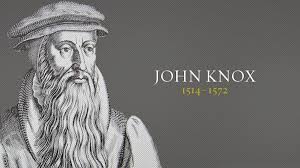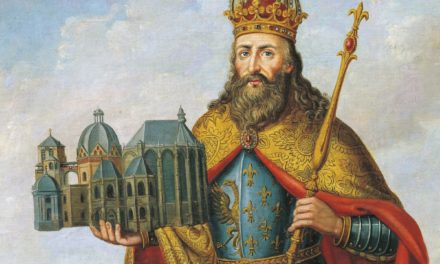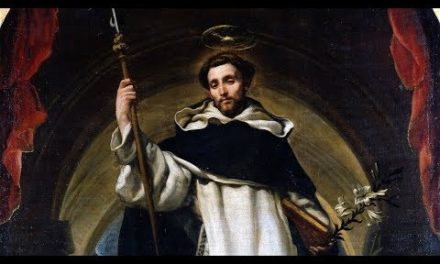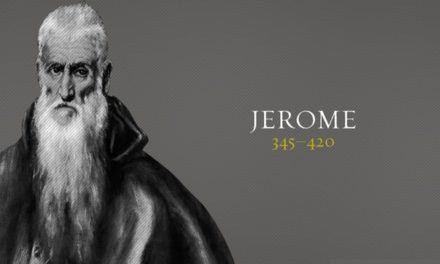This Episode is titled, Knox, Knox, Who’s There?
John Knox was born in 1514 in the small burgh of Haddington, south of Edinburgh. At the age of 15 he entered the University of St. Andrews to study, not golf, but theology. After 7 yrs he was ordained a Roman Catholic priest and became a notary since his studies specialized in the Law. Being a gifted speaker, he was employed as a tutor for the sons of some local lairds, a term referring to lower rung of Scottish nobility.
Dramatic events unfolded in Scotland during Knox’s youth. Many were angry with the Roman church which owned more than half the land and gathered an annual income of almost 20 times that of the crown. Bishops and priests were more often than not political appointments, and many so morally corrupt, they didn’t even try to hide their debaucheries. Cardinal Beaton, archbishop of St. Andrews, openly consorted with concubines, fathering ten children.
The constant traffic between Scotland and Europe saw much Protestant literature smuggled into the country. Church authorities were alarmed by the pernicious German “heresy” as they labeled it and tried to suppress it. Patrick Hamilton, an outspoken Protestant convert, was burned at the stake in 1528.
In the early 1540s, while tutoring the sons of Protestant families, Knox came under their influence, and at the preaching of Thomas Guilliame, joined them. Knox then became a bodyguard for the firebrand Protestant preacher George Wishart, at that time touring Scotland.
In 1546, Cardinal Beaton had Wishart arrested, tried, strangled, and just to make sure everyone knew how mad he was, Wishart’s body was burned. The Protestants decided such outrage would not go unanswered. So sixteen Protestant nobles stormed the castle, assassinated Beaton, and mutilated his body in retribution for what he’d done to Wishart, who posthumously could wonder where they’d been earlier. Might have been a little smarter for them to take the castle when he was still a prisoner. Oh well.
With the castle now in Protestant hands, a fleet of French ships arrived and laid in a siege. Catholic France was an ally to Catholic Scotland. Though Knox was not party to the Cardinal’s murder, he did approve of the action, and during a break in the siege, joined the besieged inside the castle to show solidarity.
This siege wasn’t your typical surrounding of a castle where the attackers try to starve the besieged into submission. It was a half-hearted, partial siege, more about appearances than an earnest attempt to bring the Cardinal’s killers to justice. So, life wasn’t disrupted for the people in the castle all that much. Things went on pretty much as normal.
Then, during a church service one Sunday, Protestant preacher John Rough spoke on the election of ministers, turned to John Knox and asked if he’d please take on the office of resident preacher. When the congregation confirmed the call, Knox was overwhelmed and reduced to tears. At first he declined, thinking himself unqualified, but eventually submitted to what he quickly realized was the call of God. It was a short-lived ministry. In 1547, the siege of St. Andrews Castle was laid on in earnest and the Protestants had to surrender. Some were imprisoned while others like Knox were made galley-slaves. Which, if you know anything about that, sends a shiver up your spine. You’d be hard pressed to find a lower lot for a man to sink to. An ironic post for a man who’d just wept in humility at being called to pastor a church.
A year and a half passed before Knox and his fellow galley-slaves were released. That they lived a year and a half is a miracle in itself. Knox spent the next five yrs in England, and his reputation for preaching boomed. When the Catholic Queen Mary Tudor inherited the throne from her brother Edward VI in Oct 1553, Knox fled to France. Smart move, since Mary did her best to reverse the path toward Protestantism her brother had followed. She executed so many she’s known to history as “Bloody Mary.”
Knox’s choice of France as a place of refuge seems odd, since things were little better there than in England. He soon realized that as well and made his way to Geneva, where he met John Calvin. Calvin described Knox as a “brother … laboring energetically for the faith.” Knox was so impressed with Calvin’s Geneva, he called it, “the most perfect school of Christ that was ever on earth since the days of the apostles.”
Knox was then sent by Calvin to the German city of Frankfurt to pastor a church of Protestant English refugees. There, he quickly became embroiled in controversy. The Protestants couldn’t agree on an order of worship. Arguments became so heated one group stormed out, refusing to worship in the same building as Knox.
I mention this little moment in Knox’s life because it becomes sadly indicative of what begins to happen all across Europe as the Reformation spread. Once people split off from the Roman Church, they kept splitting off from each other. While it’s difficult for us to understand this in our age of pluralism, the people of Europe in the 16th C assumed you had to be a part of some church. And that group was either allied with the State, or wanted to be. There just wasn’t a large block of people who were unaligned religiously. Atheism was simply not tolerated. So once the monolithic hegemony of the Roman Catholic church was broken, the cracks that formed in religious faith kept going, like a windshield. And the various groups thought they needed to grab some kind of power or they’d end up the victim of someone else’s. This helps explain why the usually pacifist Anabaptists became militant in Munster, as we saw in an earlier episode.
My point here is that the rift that formed in Frankfurt over whether or not to use the Anglican Book of Common Prayer, and whether or not people ought to kneel while taking Communion was typical of the battles the Protestant church faced at this time. Looking back, we might shake our heads at such pettiness. But let’s be careful. Do not our churches sometimes split over issues just as petty? We might think they aren’t, but would believers 500 years from now call them so?
While Knox was in Germany, Protestants in Scotland redoubled their efforts, and congregations formed all over the country. A group called “The Lords of the Congregation” vowed to make Protestantism the religion of the land. In 1555, they invited Knox to return to Scotland to inspire the reforming task. Knox spent nine months preaching all over Scotland before he was forced to return to Geneva.
There in Geneva he published some of his most controversial tracts. In his Admonition to England he attacked leaders who allowed Catholicism back into England. In The First Blast of the Trumpet Against the Monstrous Regiment of Women he argued that a female ruler, like the English Queen Bloody Mary was “most odious in the presence of God” and that she was “a traitoress and rebel against God.” In another broadside he extended to ordinary people the right—indeed the duty—to rebel against unjust rulers. As he later told Mary, Queen of Scots, “The sword of justice is God’s, and if princes and rulers fail to use it, others may.”
Not really sure where Knox got that idea from Scripture, since Romans 13 does say it IS the duty of the civil government to wield the sword and citizens are to submit to that authority. It also says Vengeance belongs to the Lord – HE will repay. In any case, Knox made a case for rebellion against unjust government many found to their liking.
Knox returned to Scotland in 1559, and again deployed his formidable preaching skills to increase Protestant militancy. Within days of his arrival, he preached a rousing sermon at Perth against Catholic “idolatry” which caused a riot. Altars were demolished, images smashed, and churches destroyed.
In June, Knox was elected the Minister of St. Giles Church in Edinburgh, where he continued to exhort and inspire. In his sermons, Knox typically spent half an hour calmly exegeting a biblical passage. Then as he applied the text to the situation in Scotland, he vigorously pounded the pulpit, calling for people to immediately install the application.
The English, now under the Protestant Queen Elizabeth I, came to the aid of the Protestant Scots while the French aided the Catholics. Fired up by Knox’s preaching, The Lords of the Congregation armed themselves and occupied several cities. In 1560 at the Treaty of Berwick, the English and French agreed to leave Scotland. The future of Protestantism in Scotland was assured.
The Scottish Parliament then asked Knox and five colleagues to write a Confession of Faith, the First Book of Discipline, and The Book of Common Order—all of which cast the Protestant faith of Scotland in a distinctly Calvinist and Presbyterian mode.
Knox finished out his years as preacher at St. Giles, helping shape the developing Protestantism in Scotland. During this time, he wrote his History of the Reformation of Religion in Scotland.
Though he remains a paradox to many, Knox was clearly a man of great courage: one man standing before Knox’s open grave said, “Here lies a man who neither flattered nor feared any flesh.” Knox’s legacy is large: his spiritual progeny includes some 750,000 Presbyterians in Scotland, 3 million in the US, and many millions more worldwide.
When visiting Edinburgh some years ago, I had a chance to visit St. Giles. It’s an impressive cathedral church. You can definitely see the difference from a classic Roman Catholic Cathedral, which it was before the Reformation. But long Protestant occupation has removed many of the ritual furnishings of a Catholic church.
Down the street from St. Giles is Knox’s house where he lived before being elected Minister at St. Giles. He lived there when Catholics ruled and he was banned from preaching in public. His multi-storied house juts out into the street, forming a little corner traffic has to flow around. So it was something of a bottleneck. Knox couldn’t obtain a license for public preaching, but no one could stop him from saying whatever he wanted in his own home. So Knox would open his window overlooking the street and preach fine messages, knowing large crowds gathered outside to listen. He even engraved scriptures in his window and door frames.
What’s sad is that Knox’s grave lies right next to St. Giles. But being some of the most prime real estate in all Scotland, just a few yards of the Royal Mile, today it lies under a parking space. Seriously! There’s an asphalt parking lot with white lines for cars to park. And smack dab in the middle of one parking spaces is a little plaque marking that this is the burial place of John Knox.
Hardly anyone knows it’s there. When people are shown it, the response of many is, “Who’s John Knox?”





